Complete Solutions to EXERCISE -4 of chapter ELECTRIC CHARGES AND FIELDS of Class 12 book with complete answers and questions
| Class 12 | PHYSICS |
| Chapter | ELECTRIC CHARGES AND FIELDS |
| NARAYANA | EXERCISE -4 |
| Number Of Questions | 43 |
| Academic Year | 2023-24 |
An electron moving towards the east enters a magnetic field directed towards the north. The force on the electron will be directed
View SolutionA conducting spehre has a radius 30 cm .If the dielectric strength of surrounding air is `3'10^(6)` V/m, the maximum amount of charge the sphere can holdin micro coulombs is
View SolutionThree identical conducting spheres A, B and C are given charges +Q, +q and -2Q respectively. A and C are brought in to contact and separated. Next B and C are brought in to contact and separated. If A,B and C are arranged so that their centres form an equilateral triangle and they do not touch each wihich of the following statement is correct regarding the forces between the pairs
(A,B),(B,C), and (C,A)?
View SolutionA regular tetrhedron has four identical faces each an equilaterla triangle of side L. A charge +q is kept at one of the vertices. The magnitude of electric intensity due to this charge at thecentroid of the face opposite tio it is `(k=1//4 pe_(0))`
View SolutionAn electric dipole produces electric field in its surroundings.The angle between the directions of electric field at any point on the axial line and the electric field at any point on the equatorial line is
View SolutionA conducting sphere that carries a total charge of -3q is placed at the centre of a conducting spherical shell that carries a total charged of +5q. The conductors are in electrostatic equilibrium. The charges on the inner and outer surfaces of the shell are respectively.

View SolutionA small bob is suspended from the roof with a string and hangs vertically. The bob is given a charge +q and a uniform horizontal electric field is set up o the neighbourhood of the bob. Now the bob hangs intjhe field such that the string makes an angle of `30^(@)` with the vertical. If the charge on te bob is made +3q, and the bob once again comes to equilibrium, then the angle made by the string with the vertical will be
View SolutionTwo small balls, each having equal positive charge `Q` are suspended by two insulationg strings of equal length `l` from a hook fixed to a stand. It mass of each ball `=m` and total angle between the two strings is `60^(@)`m, then find the charge on each ball.

View SolutionTwo infinitely long straight conductors each having a charge density lamda are arranged parallel to each other. The spearation between them is d. What happens to the force per unit length on each conductor, when the separation between them is doubled?
View SolutionTwo point charges are fixed on the Xaxis , `q_(1)=12.0mC` is located at the origin and `q_(2)=-3.0mC` is located at point A, with `x_(2)=8.0cm`. Where should a third charge `q_(3)`, be placed on the X-axis so that the total, electrostatic force acting on it is zero?
View SolutionAn equilaterial triangle ABC has a side a. Two infinitely long thin straight wires having uniform linear charge densities ' lamda ' and '-lamda' are arranged at A and B perpendicular to the plante of the triangle. The magnitude of electric intensity at the third vertex c will be
View SolutionConsider the the following statemetns and select the correct opiton /s from those given below the statements.
a. An electron released for rest in a uniform field always increases its kinetic energy.
b. An electron fired in the direction of a uniform electrc field always speeds up.
c. An electron fired perpendicular to a uniform electric field traverses a parabolic path.
View SolutionA uniform electrif field of intensit E is in the Y-negative direction. An electron of mass m and charge e is fired through the origin with initial velocity u in the X-positive direction. The displacement undergone of the electron during a time interval t is
View SolutionA point charge +Q is surrounded by two uncharged concentric conducting shells as shown. The region of space inside the inner shell is A, the region of space between the two shells is B and the regionof space outside of the outer shell is C. Regarding the electric field whihc of the following is correct?
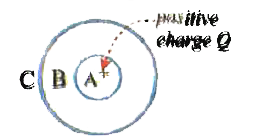
View SolutionTwo isolated metal spheres are identical. They are electrically neutral and are touching. An electrically charged rod is then brought near the spheres without touching them, as the drawing shows. After a while, with the rod held in place, the spheres are separated, and teh rod is then removed. The following statements refere to the mases `m_(A)` and `m_(B)` of the spheres after they are separated and the rod is removed. Which of the follownig statements is true?

View SolutionA positive charge kept at one of the vertices of a regular hexagon produces electric intensity E at the centre of the hexagon. If the charge is moved to an adjacent vertex, the magnitude of change in the electric intensity will be
View SolutionFigure shows three charges `-q,+q,` and `-2q` kept at points A,B and C respectivley. OA =OB=OC=r. The electric field inteinsity at O has a magnitude of

View SolutionTwo charges each +q are at the vertices of the equilateral triangle of side a as shown. A is a vertex, B is midpoint of the side and C is a point at a distance as from the right vertex as shown in the figure. THE magnitudes of electric intensities at A, B and C are respectively. The correct ascending order of these intensities is

View SolutionFour electrical charge are arranged on the corners of a 10cm square as shown.
What would be the direction of the resulting electric field at the center point P?
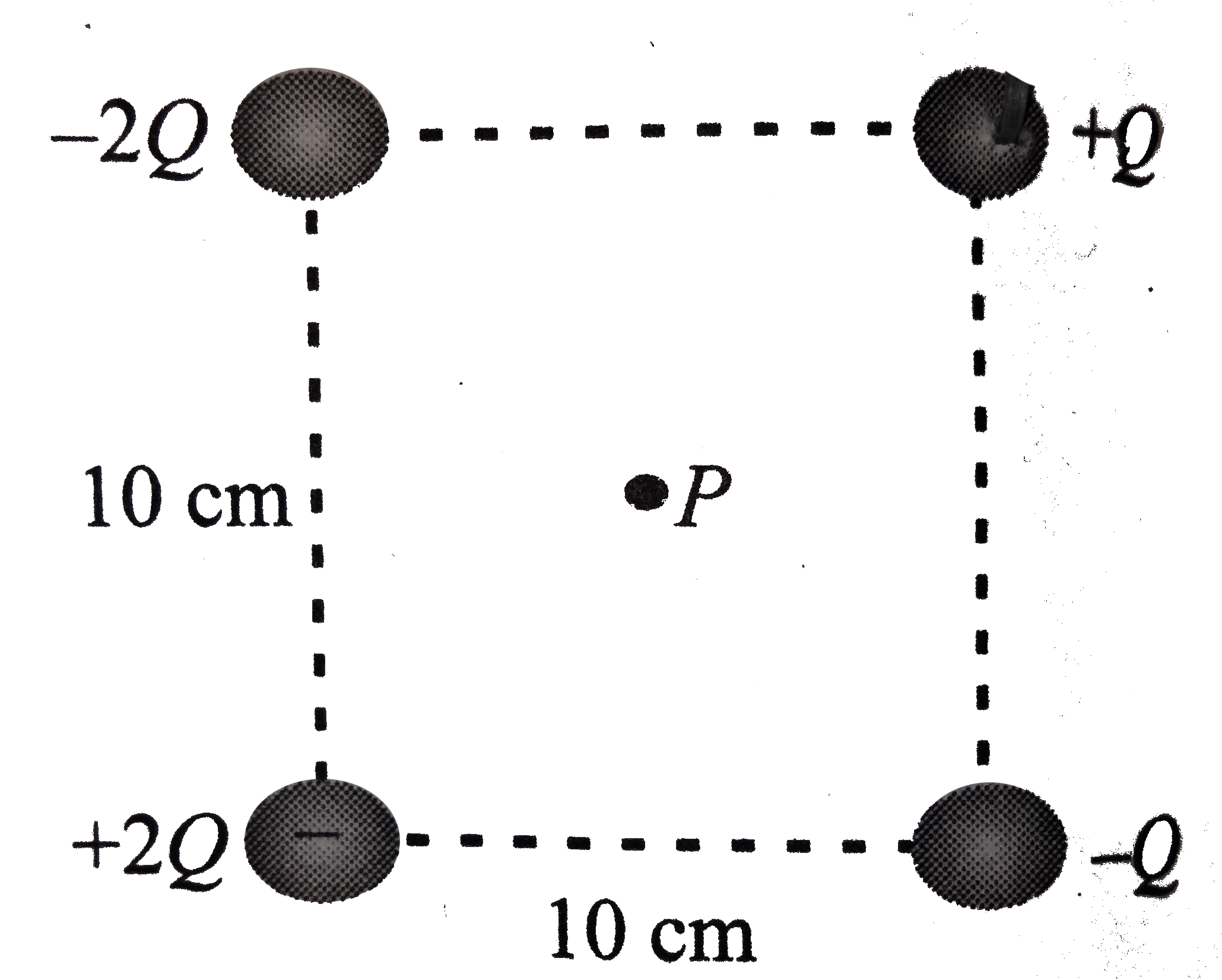
View SolutionTwo small identical balls are suspened from a common point by two identical strings. When they are given identical charges, they move apar and the strings make with the vertical an angle of q. Now the system is immersed in a liquid and as a result the angle q does not change. If r is the density of the material of the balls and s is the density of the liquid, the dielectric constant of the liquid is
View SolutionLet there be a spherically symmetric charge distribution with charge density varying as `rho(r)=rho(5/4-r/R)` upto `r=R`, and `rho(r)=0` for `rgtR`, where r is the distance from the origin. The electric field at a distance r(rltR) from the origin is given by
View SolutionA spherical portion has been removed from a solid sphere having a charge distributed uniformly in its volume as shown in the figure. The electric field inisde the emptied space is
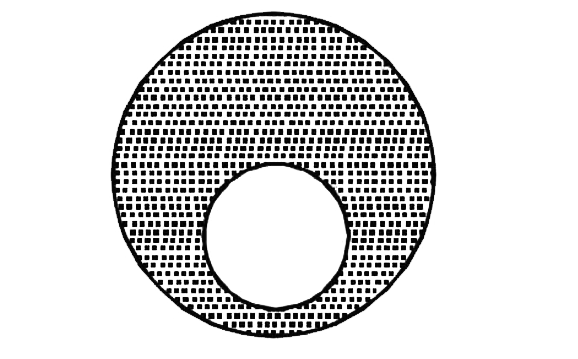
View SolutionAn isolated solid metal sphere of radius `R` is given an electric charge. The variation of the intensity of the electric field with the distance `r` from the centre of the sphere is best shown by
View SolutionThree charges +q, +q, +2q are arranged as shown in figure. What is the field at point P (center of side AC)
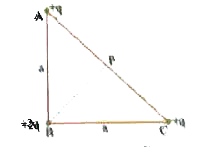
View SolutionPoint P is at a distance of `r(gtR)` from the axis of the cylinder. The volume charge densilty and radius of this cylinder are n and r respectively
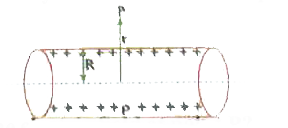
What is the electric field at point P?
View SolutionAn electron is projected as in fig. at a speed of `6`x`10^(6)ms^(-1)` at an angle of `45^(@) E=2000Vm^(-1)` directed upward `d=3cm` and 1=10cm. Will the electron strike either of the plates?
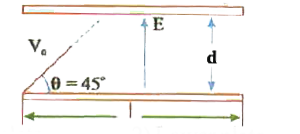
View SolutionTwo large conducting plates are placed parallel to each other with a separation of d between them. An electron starting from rest near one of the plates reaches the other plate in time t. If e is the charge on the electron and m is its mass, then the surface charge density on the inner surface is
View SolutionThree charges `-q_(1), +q_(2)` and `-q_(3)` are placed as shown in the figure. The `x`-component of the force on `-q_(1)` is proportional to
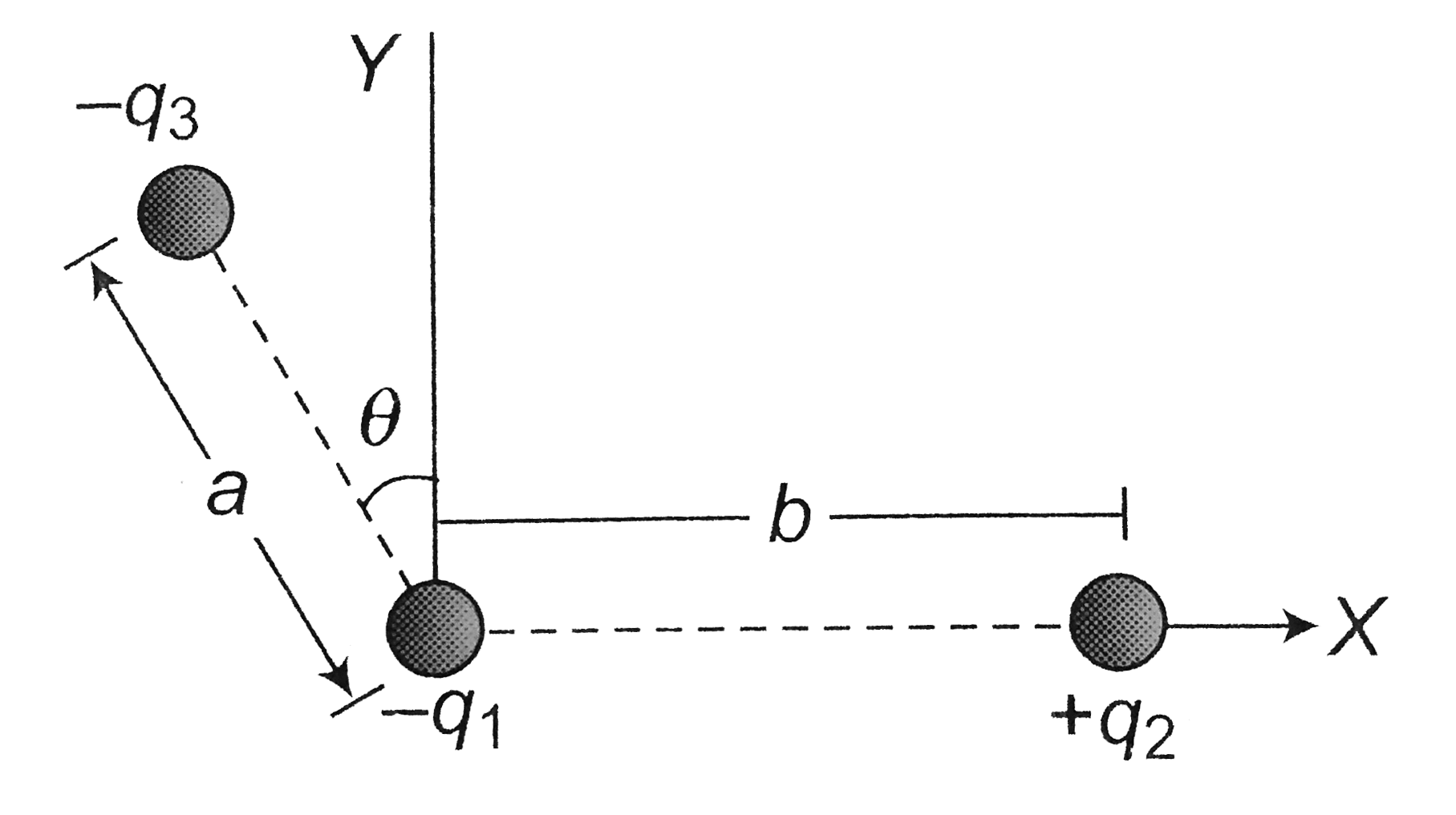
View SolutionAn electron is projected from a distance `d` and with initial velocity `u` parallel to a uniformly charged flat conducting plate as shown. It strikes the plate after travelling a distance `l` along the direction of projection. The surface charge density of the conducting plate is equal to
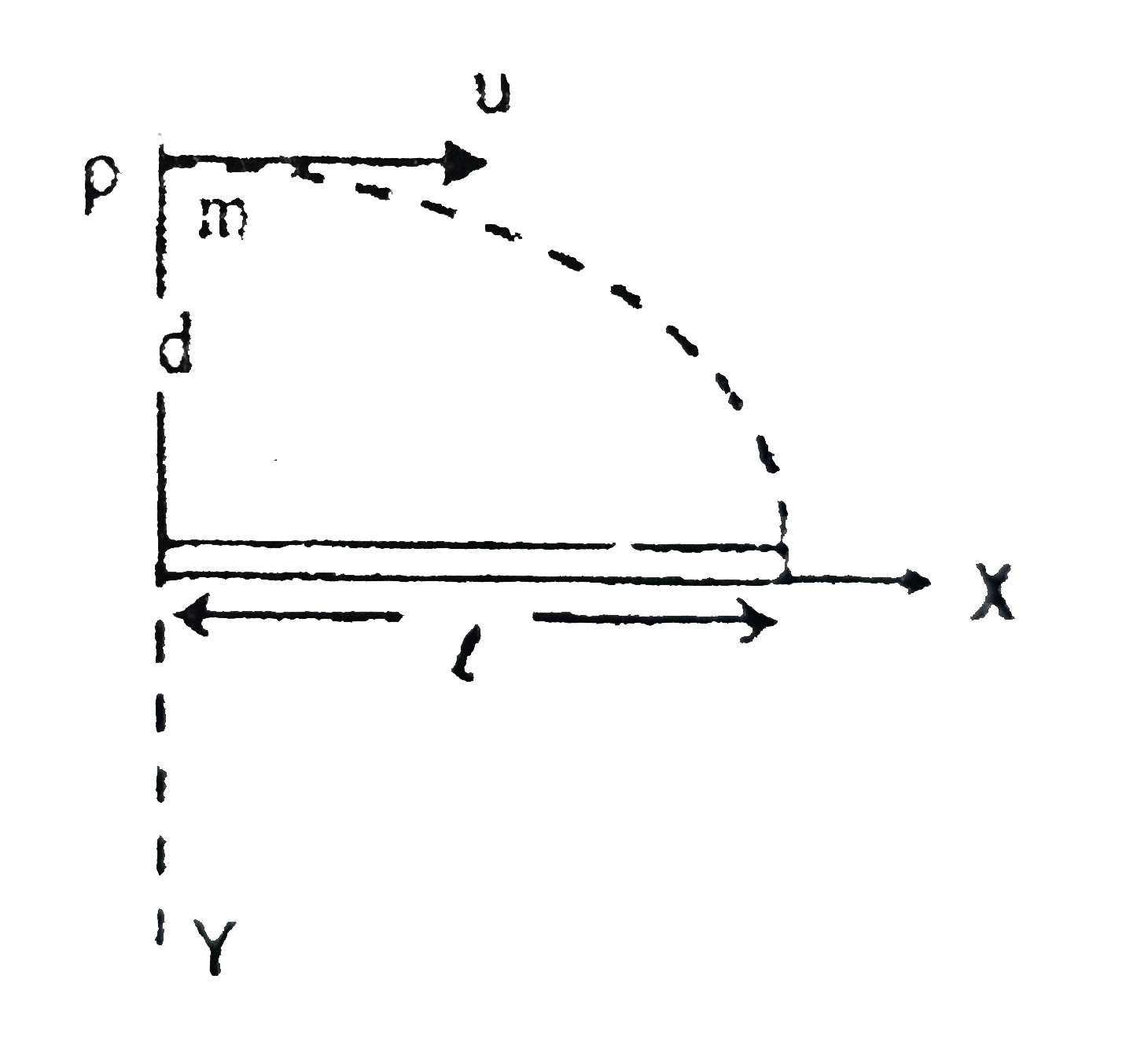
View SolutionThree large parallel plates have uniform surface charge densities as shown in the figure. What is the electric field at `P`
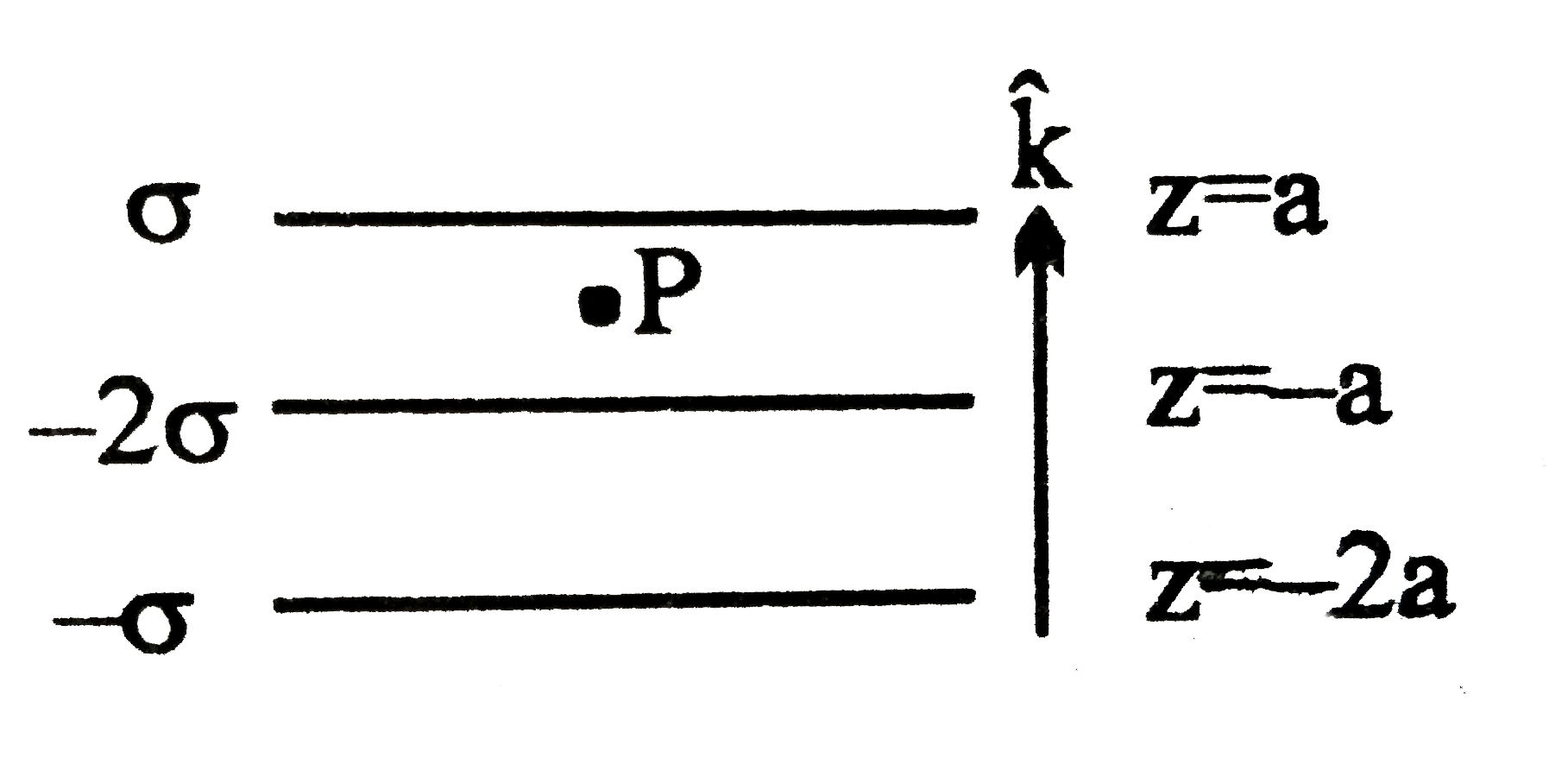 .
.
View SolutionA particles of mass `1kg` and carrying positive charge `0.01C` is sliding down an inclined plane of angle `30^(@)` with the horizontal .An electric field `E` is applied to stop the particles.If the coefficient of friction between the particles and the surface of the plane is `(1)/(2sqrt(3))`. E must be
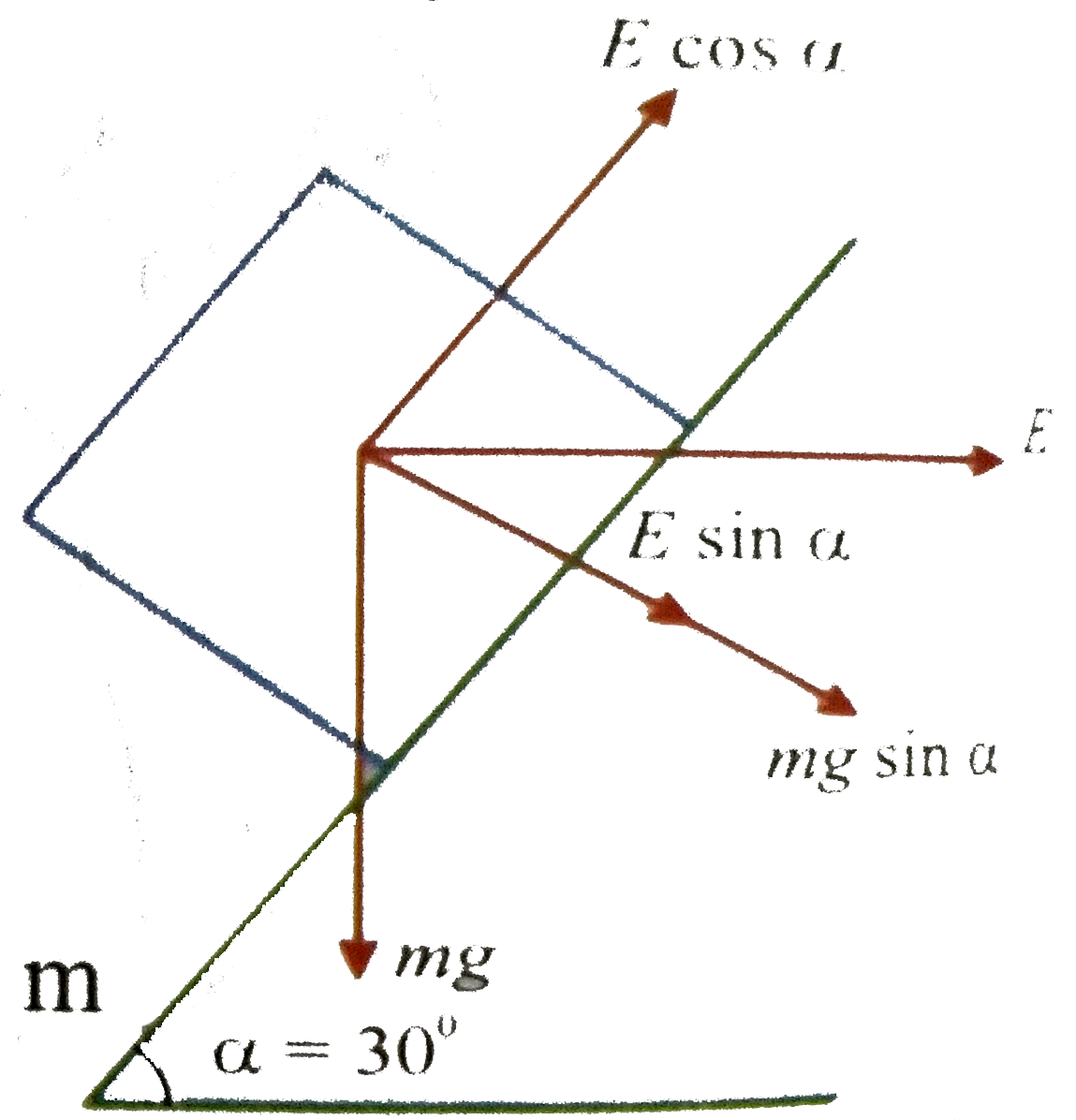
View Solutionsix charges of equal magnitude, 3 poistive and 3 negative are to be placed on PQRSTU corners of a regular hexagon, such that field at the centre is double that of what it would have been if only one +ve charge is placed at R. Which of the following arrangement of charge is posisble for P, Q, R, S, T and U respectively.
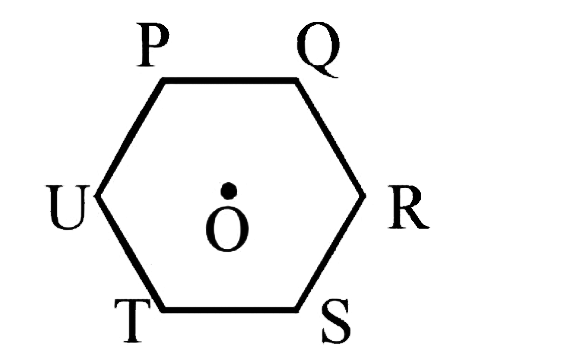
View SolutionThree concentric metallic spherical shells of radii R, 2R, 3R are given charges `Q_(1) Q_(2) Q_(3)`, respectively. It is found that the surface charge densities on the outer surface of the shells are equal. Then, the ratio of the charges given to the shells `Q_(1) : Q_(2) : Q_(3)` is
View SolutionIf `E_(a)` be the electric field strength of a short dipole at a point on its axial line and `E_(e)` that on the equatorial line at the same distance, then
View SolutionA positive charge Q is uniformly distributed along a circular ring of radius. A small test charge q is placed at the centre of the ring. Then A. If `qgt0` and is displaced away from the centre in the plane of the ring., it will be pushed bactowards the centre.
B. If `qlt0` and is displced away from the centre in the plane of the ring, it will never return no the centre and will continue moving til it hits the ring.
C. If `qlt0`, it will performe SHM for small displacement along the axis.
D. Q at the centre of the ring is in an unstable equilibrium within the plane of the ring for `qgt0`
View SolutionA hemispherical shell is uniformly charge positively .the electric field at point on a diameter away from the centre is directed
View SolutionA point charge +q, is placed at a distance d from an isolated conducting plane. The field at a point P on the other side of the plane is
View SolutionAn insulator (non-conductor) can be charged by
a. conduction (b) induction (c) friction
View SolutionWhich one of the following graphs represents the variation of electric field with distance r from the centre of a charged spherical conductor of radius R?
View SolutionIn a liquid medium of dielectric constant `K` and specific gravity `2` two identically charged spheres are suspended from a fixed point by threads of equal length .The angle between them is `90^(@)` .In another medium of unknown dielectric constant `K^(1)` and specific gravity `4` the angle between them become `120^(@)` if density of material of spheres is `8gm//c c` then` K^(1)` is
View SolutionA particle of mass `1kg` and carrying `0.01C` is at rest on an inclined plane of angle `30^(@)` with horizontal when an electric field of `(490)/(sqrt(3))NC^(-1)` applied parallel to horizontal .The coefficient of friction is
View Solutionv33.2
View SolutionA bob of a simple pendulum of mass `40gm` with a positive charge `4xx10^(-6)C` is oscillating with a time period `T_(1)`.An electric field of intensity `3.6xx10^(4)N//C` is applied vertically upwards.Now the time period is `T_(2)` the value of `(T_(2))/(T_(1))` is `(g=10//s^(2))`
View Solution
EXERCISE -4 questions and complete solutions for chapter ELECTRIC CHARGES AND FIELDS of NARAYANA PHYSICS (HINGLISH) of Class 12